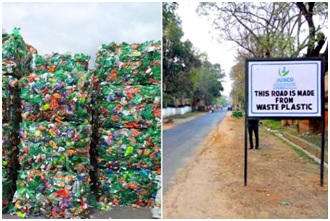The disposal of plastic is a major problem everywhere in today’s scenario. The plastic we use mainly consists of low-density polythene and non-biodegradable. The burning of these plastic wastes causes environmental pollution. Laboratory experiments conducted on bituminous materials proved that waste plastic enhances the property of the mix. The improvement in the property of bituminous mixes provides a solution for disposal of plastic in a useful way. Since bottles, containers, plastic strips used in packing are increasing day by day. As a result, the amount of waste plastics is also increasing. This leads to various environmental pollution. These wastes produced today will remain in the environment for many years leading to various environmental concerns. Therefore it is very necessary to utilize the wastes effectively using modern techniques in each field.
Many by-products are produced in making plastic bags. The wastes consisting of carrying bags, cups, and other utilized plastics can be used as a coating on aggregate and coated aggregates can be used for road construction. The mix polymer coated aggregate and modified bitumen have shown greater strength. The roads which are constructed using plastic wastes, which are known as plastic roads are found to perform better compared to those constructed with conventional bitumen. The Indian Center for Plastics in the Environment (ICPE) has been promoting the use of plastic waste in construction of asphalt roads.
There are two kinds of plastic roads:
1) The plastic road is constructed with modular, hollow and prefabricated road elements which are made from consumer waste plastics.
2) Plastic roads consist of an asphalt mix with plastic waste incorporated with asphalt mixture.
Advantage of Plastic Roads:
In hot climates, road surfaces with neat bitumen can cause bleeding, may develop cracks in cold climates and possess fewer load bearing capacity. This can cause serious damage because of the higher axle load of vehicles in present condition due to rapid infrastructure development. The useful life of the bituminous layer decreased to 7 to 8 years from an average life of 5 to 6 years. The use of plastic waste materials with bitumen mixes enhances the pavement performance. The cost of construction of the road is also low. In this way we can protect the environment to some extent.
Laboratory Experiment Result:
The penetration value of the bitumen mixes decreases with increase in the percentage of polymer. It is because the addition of polymer increases the hardness of bitumen. The ductility of the bitumen mixes also decreases due to addition of polymer. The decrease of value of ductility is due to interlocking of polymer molecules with bitumen. Flash and fire point of the bitumen mixes increase with increase in the amount of polymer. That is why plastic road surfaces are less affected by fire hazards. It also shows that the bitumen blend has better resistance towards water. It is also due to the binding property of polymer bitumen mix. The Marshall Stability Value is high.The softening point also increases due to increase in addition of plastic to the bitumen. Higher is the amount of plastic added, higher is the softening point value. It is due to the chemical nature of polymer added. The increase in the value of softening points results in less bleeding during summer. Since bleeding accounts for increased friction between the tyre of a moving vehicle and road surface, and on the other hand it accounts for slippery conditions in rainy periods. These two adverse conditions can be overcome by polymer bitumen blend.
Significance of Plastic Roads:
I. The total material cost of the project is reduced almost by 8%.
II. The modified bitumen with plastic gives better results as compared to ordinary bitumen.
III. The optimum content of plastic with bitumen should be 5% to 10%.
IV. Since plastic has a property of absorbing sound, the use of plastic roads will help in reducing sound pollution caused by heavy traffic.
V. The bitumen mixed with polymer, as a road construction material improves the quality and performance of the road.
VI.There is no effective radiation of UV Rays.
VII. Zero maintenance cost.
VIII.It will give employment for unskilled laborers.
Plastic Roads in Use:
Many countries like Australia, Indonesia, United Kingdom, USA, South Africa, and Vietnam have used the technology which can incorporate plastic waste into asphalt mix. In India, the technology for plastic roads was developed by a man named Prof. RajagopalanVasudevan. He is a Professor of Chemistry at Thiagarajar College of Engineering, Madurai. He is known as the plastic man of India. He developed the technique for reuse of plastic waste to construct better, more durable and cost effective roads. Chennai is the first city in India to implement this technology. In November 2015, the Central Government of India made it mandatory for all road developers in the country to use waste plastic, along with bituminous mixes for construction of roads. This is an initiative which falls in line with the Government’s Swachh Bharat Mission which aims to address India’s garbage crisis. A survey done in December 2019, India has built a total 21,000 miles of roads using plastic waste. There are total 33,700 km of plastic roadways in the country. It is said that almost one million plastic bags are used every one km of road.

Fig:Plastic Road in India
Conclusion:
The use of waste plastics on the road helps us to provide a better place for burying the plastic waste. It will end the disposal problem of plastics. At the same time, better roads are also constructed. This technique will also help us to avoid the general disposal technique of waste plastics namely land-filling and incineration which have certain burdens on ecology.
If you have a query, you can ask a question here.


